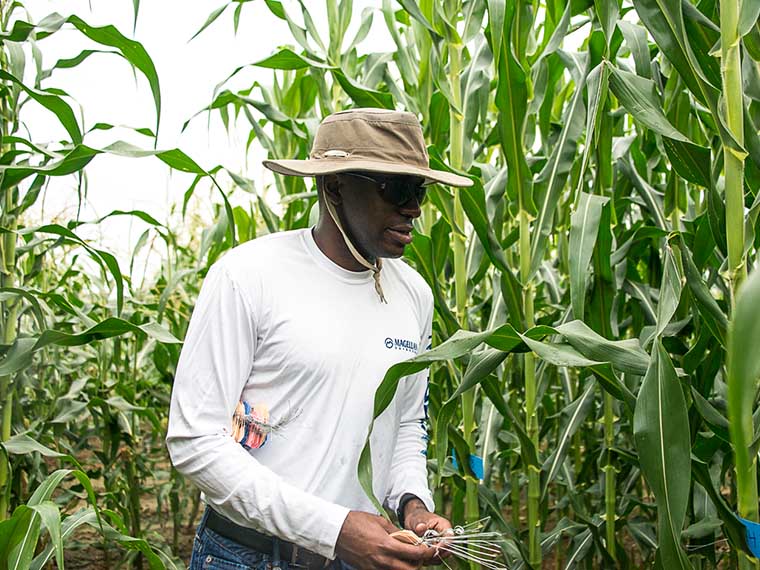The information presented on this page may be dated. It may refer to situations which have changed or people who are no longer affiliated with the university. It is archived as part of Mississippi State University's history.
Sometimes, in research, analytical tools developed to solve problems do not always work as expected. Then again, sometimes they perform perfectly. This is particularly true for Cedric Reid, a doctoral student in the biochemistry, molecular biology, entomology and plant pathology in the College of Agriculture and Life Sciences.
Reid's research seeks to understand the interaction of Aspergillus flavus fungus and the toxin it creates called aflatoxin, in corn. He works with scientists in the Mississippi Agricultural and Forestry Experiment Station, Mississippi State Chemical Lab, and the USDA Agricultural Research Service.
Aflatoxins are highly carcinogenic compounds produced by the soil-borne fungus Aspergillus flavus. Aflatoxins can infect numerous crops including cotton, peanuts, and corn during production, harvest, storage, and processing. In the U.S., aflatoxin is primarily an economic issue, costing producers around $225 million in disposed corn each year. In developing countries, aflatoxin presents a food security and public health issue that affects nearly 25 percent of the world's food supply.
To understand how the A. flavus spreads throughout the plant and then field, Reid has been inoculating corn hybrids with the fungus. The hybrids used in his study include those susceptible to aflatoxin, those with resistant genes, and a cross of the susceptible and resistant hybrids.
His goal is to determine what happens at the initial site of the infection, where he inoculated the kernel, and then what happens to the whole cob. In particular, he wants to see which genes and proteins are turned on from the injection of aflatoxin.
His study, under the direction of MAFES scientists Drs. Darrell Sparks and Ashli Brown Johnson, has produced numerous analytical tools, one of which resulted in a single kernel assay. By singling out aflatoxin in an individual kernel, Reid created a blueprint to compare with other corn kernels in order to determine the amount of aflatoxin present.
Aflatoxin flourishes when the fungus and the plant are under stress, either through high temperatures, drought, insect damage, or other environmental conditions. Using the single kernel assay, he was able to determine that the resistant and cross hybrids are somewhat effective at resisting aflatoxin, even after being injected with the fungus.
"The single kernel assay is an important tool for researchers to continue their work in ridding aflatoxin from the food supply," Reid said. "Aflatoxin is a particularly hard compound to eliminate because it is produced by soil-borne fungi and exists everywhere. The single kernel extraction method is a useful technique in determining how aflatoxin affects infected corn."
While other analytical tools developed by Reid did not work as expected with aflatoxin research, they are showing promise in another area of research. Reid was able to determine compounds that affect non-target crops from herbicide drift and volatility.
Volatility is the movement of the gaseous form of the herbicide as a liquid, after it has been applied to its intended target. Drift is the physical movement of herbicide by wind after it leaves the sprayer but before it reaches its intended target.
As more and more herbicide-resistant weed populations develop, companies have introduced crops which are tolerant to 2,4-D and dicamba. These herbicides have been around for nearly 50 years and provide excellent weed control; however, they are detrimental to other crops that do not contain the tolerant gene.
Reid's analytical tools developed for aflatoxin work are showing promise in determining which formulations are affecting non-target crops through drift or volatility, which will aid in promoting good stewardship programs. Thus far, Reid has been able to determine the formulations used after 14 days of initial contact. He is now analyzing crops after 28 days of initial contact to see if his tools will continue to perform.
And while work continues with aflatoxin and herbicide drift, Reid's analytical tools will be an asset to researchers as they work to help producers increase yields while sustaining the environment.
Funded by the Mississippi Corn Promotion Board, National Corn Growers Association's Aflatoxin Mitigation Center of Excellence, and the Mississippi Soybean Promotion Board.

